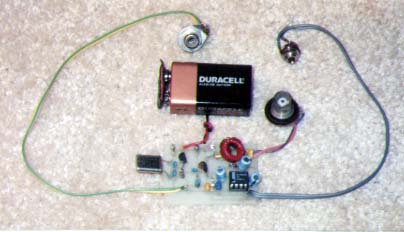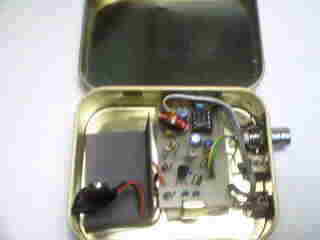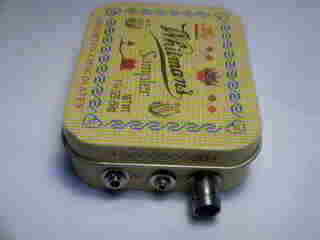WB6FZH/QRP
QRP... Low Power....High Advernture...
The HSC "PIXIE" 7040kc QRPp CW Transceiver (original)

WA6BOY's 250mw Output CW Transceiver is easy to build!
PIXIE 2 is Updated Version
The "Pixie 2" appeared in the NorCal QRP Club Newsletter on Page 47, Vol.1, #3. It is an outgrowth of RV3GM's similar circuit published in the UK QRP Club, G-QRP Newsletter, "Sprat". The circuit is simple!, it has a two transistor transmitter, using 2N2222 transistors. The oscillator transistor is always going, it supplies injection for the direct conversion receiver, and the first stage of the transmitter. An LM-386 integrated circuit provides the audio output that will drive a small speaker or headphones. The output circuit is a pi type with #26 wire wound around a T-50-2 torroid. This output network becomes the front-end L/C of the receiver. The output of the transmitter is about 250 milliwatts. 3.5 or 7.0 mhz versions may be built.
After constructing this simple radio add a pair of "Walkman" type heaphones or a small speaker and you will be able to hear signals near the crystal frequency you select. The 7040 QRP frequency crystal is often chosen. Snap on an alkaline 9volt battery and you will have power for many hours of fun. Add a key and an antenna and your station is complete. The minimum antenna for success would be a couple of 32'6" wires, one connected to the antenna and the other to board ground for a counterpoise. A good station antenna like a dipole or vertical through a tuner is best. It can not be understated that a full size antenna, and a tuner will be necessary to make contacts or even hear much with this QRPp Project.

This is a very simple radio as you can see! Any fewer parts, it does not work. You will hear many stations at the same time, there is no tuning as it is controlled by the transmit crystal. There is no volume as it is one level and you sort it out between your ears. The signal is clean and stable, as the oscillator is running all the time to inject signal for the simple direct conversion receiver. These sets have been built in 35mm film cans, medicine boxes, plasitc radio shack boxes, or anything you can think of that will hold the radio and the battery and have room for the jacks and switches you select. A dual band model was constructed utilizing a tapped torroidial winding for 80 and 40 meter bands.
This is a simple project and was packaged by HSC Electronicsfor about $10.00. Their phone number is (800)-4-HALTED and Web Site is http://www.halted.com for further information. HSC Stores have always supported the Amateur Radio Community, they have alot of surplus electronic and computer items that may interest you. Crystals suitable for use with the PIXIE are often availiable at HSC.
WB6FZH, Greg, has made contacts in CA from N.CA with the rig out in the field and at the home station.(Trinity County to Sacramento & SF Bay Areas). Remember this transmitter is at QRPp levels of output, typical 200 to 300 MW.(.02 watt). The receiver is not selective and as sensitive as your regular ham receiver. Seriously consider of making a scheduled contact with another ham for your first QSO with the PIXIE. It is better to call stations you hear with the radio than to spend endless hours calling CQ. If you suffer from depression, are easily disappointed or discouraged, do not use this radio as a primary communications device...but it is alot of fun!.
KH6/WB6FZH, while operating in Hawaii on 7040 with good location and antenna using Pixie as transmitter, and station receiver to listen, a station in Japan could hear the Pixie with great difficulty (he was asked to listen). QRP operation at slightly higher levels 1.5 and 4.75 watts was more successfull on 7mhz. to Asia, North America and Australia.

There are many additions and improvements to this and similar circuits found in the various QRP publications, Like NorCal QRPp Journal, QRPARCI, and on QRP-L on the internet. This is a simple kit as packaged by HSC and is suitable for a beginner even though there are minimal instructions.

PIXIE LINKS
- PURCHASE A PIXIE KIT HERE- Thanks Halted Technology
- SCHEMATIC DIAGRAM OF PIXIE 2
- Ultimate PIXIE PAGE- Lots of Links
- HSC WEBSITE- See Online Store (Has sold PIXIE in past!
- PIXIE from AL7FS- Pixie Project
- PIXIE 2 Project-
- PIXIE ENGINEERING INFO- Pixie Explained..
- PIXIE EXPERIMENTS- QRPI
- KB2HSH PIXIE BLOG-
- PIXIE YAHOO GROUP- Dedicated to Pixie and Pixie2
First added to WB6FZH website: December 13, 1997
Last Updated: January 2, 2009